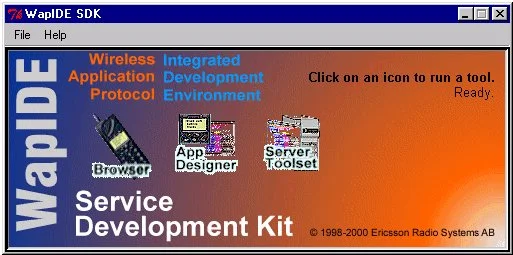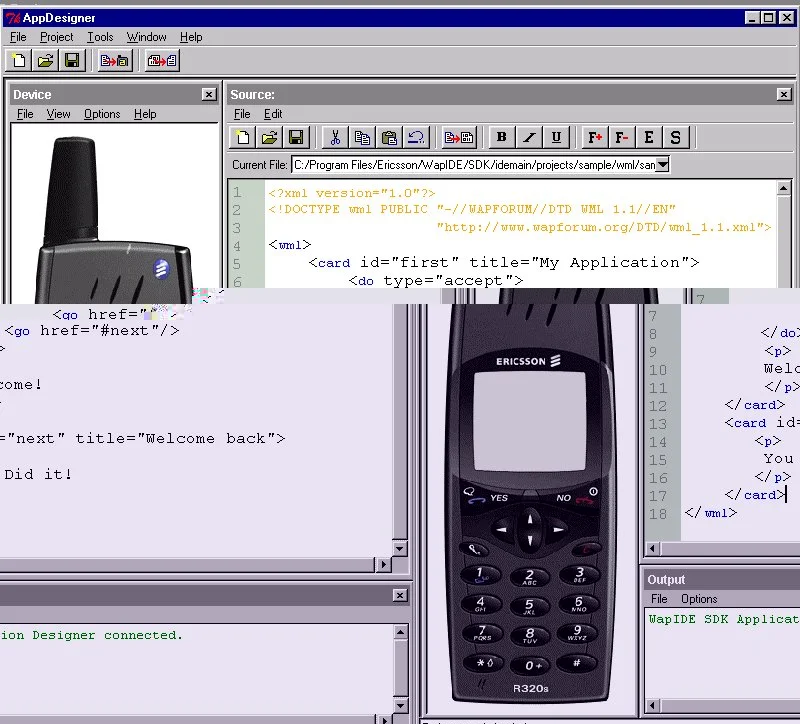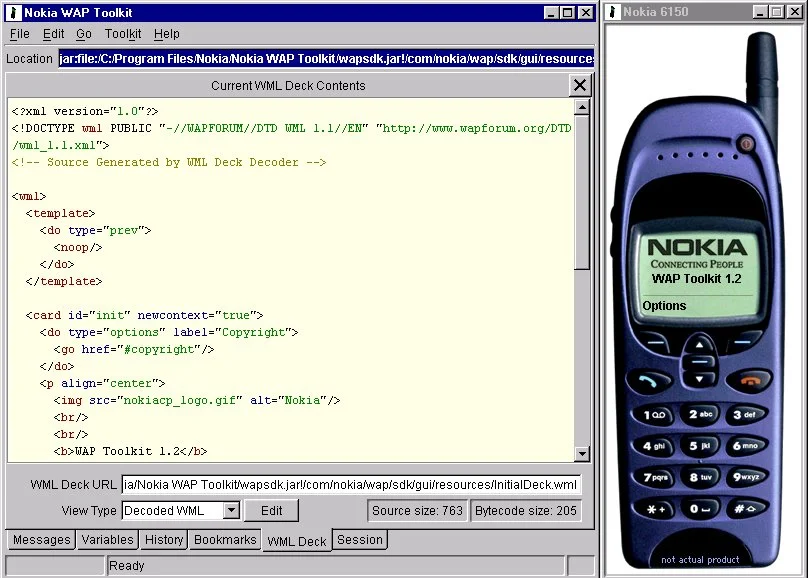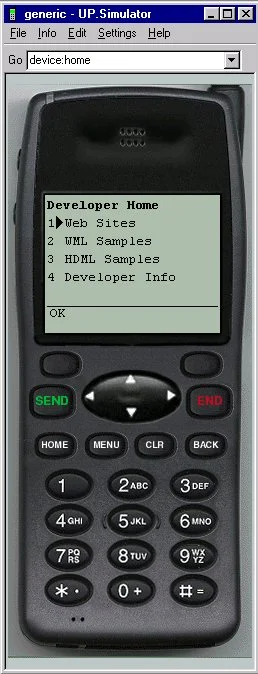While still in its infancy, the Wireless Application Protocol has certainly generated a tremendous amount of interest. As WAP services are already beginning to appear in Europe and many more are on their way in North America and Asia, a variety of WAP vendors have also made available development tools that enable WAP application development and deployment. Please note that this is not a complete WAP tutorial. In this review, we will examine three leading WAP development toolkits:
- Ericsson WapIDE 2.0
- Nokia WAP Toolkit 1.2
- Phone.com UP.SDK 4.0
While all three companies were instrumental in the formation of the WAP Forum, it is interesting to note that their development tools differ in many ways. It is also important to note that each of these companies sells commercial WAP servers which would probably be used in conjunction with their respective toolkit. We will delay a review of commercial WAP servers for a later issue.
Ericsson WapIDE 4.0
The Ericsson WapIDE product consists of a suite of tools that support the design and testing of WAP applications as well as the ability to design a new WAP device in order to test the device for look-and-feel issues. The WapIDE Software Development Kit is currently only available for Windows NT 4.0 and Windows 95/98. Included with the IDE are products for testing server applications. These products include Perl 5.0, Tcl/Tk, and the Xitami Web Server. Installing the WapIDE first requires the installation of the IDE followed by the installation of the SDK. I attempted to opt out of the Xitami Web Server installation (since I’m already running Microsoft IIS and Apache on my machine!) but the installation apparently failed at that point. I suppose one never knows when they might need three HTTP servers on one laptop! Figure 1 shows the WapIDE interface to the tools including the Browser (used to test applications), the App Designer (used to construct applications), and the Server Toolset (a set of tools including a WML/WMLScript compiler and a Syntax Analyzer).

It’s not clear to me why the Server tools weren’t simply included in the App Designer. It seems a bit disjointed to jump back and forth between applications in order to build code and then compile the code. The Browser (see Figure 2) supports the use of different devices (the R320s is the default) and allows the user to test the sample WAP URLs included with the toolkit or to test their own creations. A variety of sample WAP applications are included with the IDE for banking, stock quotes, and schedules.

The bulk of your time will be spent in the AppDesigner application (Figure 3). This tool integrates a WML editor with the WapIDE browser that coding and testing can be done within one application. It’s a bare-bones development environment with no frills. The documentation is also a bit sparse although quite a few Adobe Acrobat documents are available for download from the Ericsson WAP Developer site.

Other WAP products from Ericsson include the WAP Application Server (a Solaris-based Java application server designed to scale to 50,000 users that allows developers to build device-independent applications) and the WAP Gateway (an Intel platform-based product that acts as a server to a GSM network and bearers such as SMS and USSD).
Nokia WAP Toolkit 1.2
The WAP Toolkit 1.2 product from Nokia is similar in some respects to Ericsson’s WapIDE. Both products contain graphical development environments (though neither one supports any type of of drag-and-drop UI creation), browsers, and WML/WMLScript compilers. The Nokia toolkit currently runs only on Windows NT 4.0 but note that the Nokia WAP Toolkit also requires a Java 2 runtime. You will want to make a visit to Sun’s Java Web site to download either the Java 2 SDK or the Java 2 Runtime Environment (JRE) before evaluating the WAP Toolkit product.
After installation, the WAP Toolkit Program Group (under Windows) will contain shortcuts to the toolkit Integrated Development Environment (IDE) as well as excellent documentation on WAP, WML, WMLScript, and the toolkit itself. The toolkit application itself (see Figure 4) supports the creation, modification, and testing of WML/WMLScript code within one application.

The user can toggle between loading the WAP applications through HTTP or via a WAP gateway. Nokia also sells a separate Java Servlet-based WAP Server product. This Server incorporates the application server and WAP gateway functionality into one product. In all, the Nokia WAP products appear to be well-thought out and functional and is superior, from a user interface standpoint, to the Ericsson WapIDE product.
Phone.com UP.SDK 4.0
The Phone.com UP.SDK product (available for Windows 95/98/NT and Solaris) differs a bit from the Nokia and Ericsson product in that no graphical IDE is provided with the product. Instead of focusing on providing an integrated environment for editing and testing WML/WMLScript code, UP.SDK focuses much more heavily on providing a set of reusable code libraries for use with languages such as WML, Perl, C, C++, and Visual Basic. As Phone.com is the manufacturer of the leading WAP microbrowser, naturally the UP.SDK comes with a WAP browser known as the UP.Simulator (see Figure 5). Note that the Simulator is currently only available for the Windows platform.

You will need a live Internet connection because the simulator actually dynamically connects to the Phone.com developer Web site. It does this in order to download samples and access live WAP applications on the Web. I definitely recommend checking this product out because it will give you a good feel for how WAP can be used (I was able to check my local weather and favorite stock quotes in a manner of seconds using the Up.Simulator). The UP.SDK also includes Perl and C library functions for generating WML and handling HTTP requests as well as C++ (Solaris) and COM (Windows) objects for notification, digest, and fax handling. The UP.SDK also includes tools for requesting and installing SSL certificates for security purposes. Besides providing the standard WAP functionality, Phone.com extends WAP’s capabilities through fax and notification support. The UP.LINK server includes a Fax Manager product which allows handheld users to fax information directly from their WAP browser! Postscript, ASCII text, Microsoft Word, RTF, and Adobe Acrobat document types are accepted as fax or fax response formats. Asynchronous notifications can also be pushed to handheld clients via the Phone.com Notification API. This API allows the control of alerts, document cache, and decks on the client.
Conclusion
If you are setting out to develop your first WAP application, the Nokia WAP Toolkit product supplies excellent documentation as well as an easy-to-use graphical development environment. Meanwhile, the Phone.com product offers a great deal more capabilities but no user-friendly development tools. Of the three products, I would say that the Ericsson WapIDE tool is still a bit rough around the edges and could use some polishing. If you’re interested in WAP development, be sure to download all three of the products from the links below. Exploring the tools and building examples with them is a great way to get started learning WAP!
Links
To obtain additional information or to download evaluation copies of any of these products, visit the vendors at these sites: